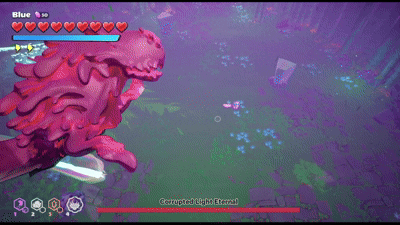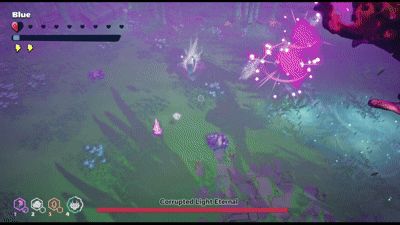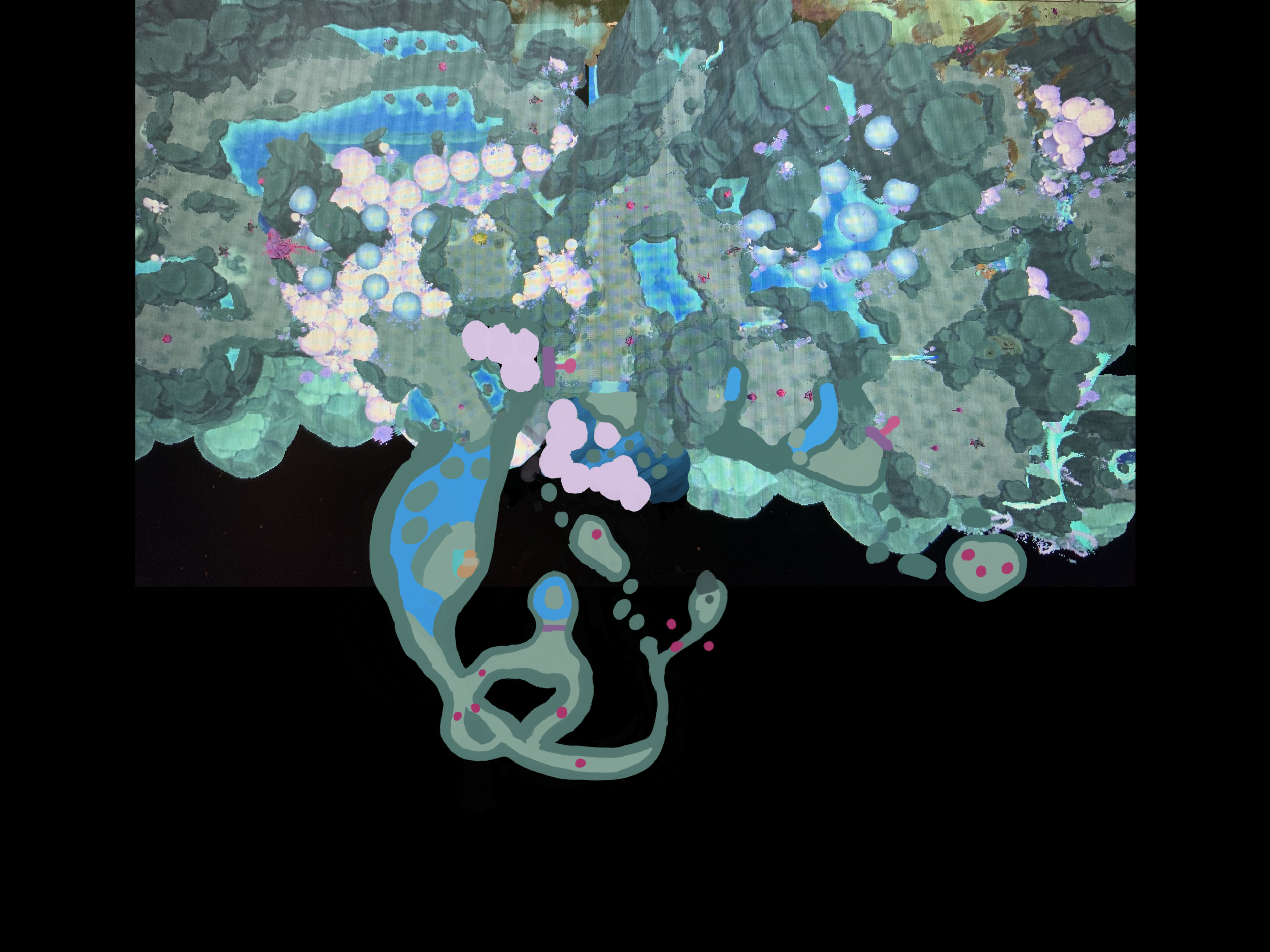
Slime Heroes
I joined the Pancake Games team for the last year and a half of the development of Slime Heroes, and in that time I learned a lot about both systems in Unreal Engine, as well as how to work effectively on a team that spans many different disciplines. Throughout this project I had my hands on almost every part of the game, including:
level/puzzle design
systems and combat balancing
online and local co-op
working with a dedicated QA team to fix many, many bugs
Below I’ve detailed a few of the key features I’ve worked on, with a focus on those that I had complete ownership over.
Check it out on Steam!
Game Trailer
Puzzle Dungeons
Each puzzle dungeon introduced a new mechanic that the user would have to interact with using the designated magic skill that was associated with the dungeon. For their designs, each dungeons had to prominently feature this new mechanic, as well as some combat encounters that allowed the player to use the skill in fun or interesting ways.
Barrier Dungeon
This was not only the first puzzle dungeon I had made for this project, but also the first thing I had worked on at all. As such, there was a bit of a learning curve that came with implementing everything to the already large project and established project, as well as finding the right balance for puzzle mechanics between what is just challenging enough to feel satisfying, but not so challenging that it becomes frustrating for the player.
Using their Barrier skill, players will have to block large lasers to prevent taking damage. The dungeon also introduces a special type of pressure plate that can only be triggered by enemies, requiring the player to control the movement of enemies, or even protect them against the lasers.
Familiar Dungeon
This was overall my favorite dungeon that I worked on, both for the design of the level itself, as well as the mechanic within the dungeon itself. Additionally, I had the opportunity to add environment art to this dungeon myself, which for the others was usually given to our Environment Artist to handle. This is a part of the level design process that I do enjoy doing myself whenever I’m able, so I really appreciated the opportunity to work on it myself for this dungeon.
Players in this dungeon have to use their Familiar to reach corrupted bubbles that are out of reach for themselves, usually in the form of corrupted vines that create a hazardous area around pillars. However, when the player clears the corruption from one pillar, it will jump to the closest pillar instead, forcing the player to clear the corruption in a specific way. This dungeon also has statues that can fully clear the corruption in an area, allowing the player to safely traverse around and on top of the pillars to get to the next area.
Pillar Dungeon
Of all the puzzle dungeon I made, I think this one is the one that initially connects most with players, and also is the one that needed the fewest iteration. The mechanic of this dungeon is easy to learn and familiar to a lot of people, yet if you don’t know the trick to solving the puzzle it can still be challenging and feel very rewarding, which is where this one succeeds most.
The mechanic for this one is pretty much a Lights Out puzzle, the player can use their Pillar skill on designated spaces to turn on or off the lights of adjacent spaces. When all the lights are on, the platform moves and the player can advance. There is also the addition of moving pillars that can be stopped or started with the Pillar skill, creating an interesting combination of a traditional Lights Out puzzle with a moving part that requires proper timing and planning.
Gas Dungeon
This dungeon was definitely one of the most unique, the ideas was a stealth dungeon where players can use their Gas skill to hide from, or sneak up on enemies. In this case, my experience building levels for Corrupted Blood really came in handy, since that game was all about classic stealth mechanics. One of the main takeaways from that project was how verticality can be a very fun option when building a stealth level, which is something I tried to capture when making this dungeon.
There were a few mechanics I added to enhance the stealth design of the dungeon. The first being vents that can pull the player’s gas skill and place it in different locations in the level. This can either help the player stealth around large sections of the level at once, or block light detectors (which are the second added mechanic). These light detectors have the function of calling all nearby enemies to the players location for a set amount of time, and are placed strategically to block entire hallways where the player has to progress. This forces the player to interact with the vents and remotely block the light detectors with their Gas skill in order to advance, unless they’re up for fight.
Battle Dungeons
The other type of dungeon in Slime Heroes is the battle dungeons, which are solely combat encounters. The challenge of these dungeons came from balancing waves of enemies in a way that felt fair, yet still challenging. The dungeons also had the goal of highlighting the different enemy types of each biome and creating encounters where their abilities could shine in unique ways. I specifically worked on the battles dungeons in the Snow, Cave, and Swamp biomes, ensuring that each of the 6 total waves in each biome felt truly distinct and special.
Snow Battle Dungeons
Cave Battle Dungeons
Swamp Battle Dungeons
Light Eternal Battle
I think this battle was one of the most fun things I had the chance to work on for Slime Heroes. This boss fight is an optional side mission for the player to discover only if they’ve completed a bunch of dungeons first. Since it’s an optional end-game boss fight, it was allowed to be quite a bit more difficult than other bosses, and there was a lot of freedom when it came to what exactly that looked like.
The Light Eternal itself is the player’s friend from the beginning of the game who has since been corrupted by the darkness and the player now has to fight in order to save. As the name suggests, their domain is “light” so their attacks had to be themed around that idea. I leaned into the “reflective” idea of light a bit and incorporated crystals that could be used to reflect the light from attacks and create hazards around the arena. In general, the Light Eternal boss is one that attacks from the distance, only closing in on the player when they are threatened by other hazards in the arena.
Domain of Light
One of the first things I had designed for this battle was the Domain of Light mechanic, I wasn’t sure exactly how to pull it off at the start, but when I pitched it to the team lead he was fully supportive of me giving it a try and figuring it out. I will always be grateful for that trust, because I’d say this is the coolest mechanic I have ever made. When the player depletes the Light Eternal’s health down to about half, and again at a quarter, the Domain of Light will trigger, transporting the player to a “mirror realm” with 5 reflections of themselves. These reflections will mirror the players actions (movement and attacks). The Light Eternal themselves will show up in one of the reflections to do an attacks, forcing the player to attack with their reflections before the Light Eternal disappears again. After a few hits against the Light Eternal, the Domain will break and players will be transported back to the original arena.
Crystals
Throughout the Arena are blue crystals that the player can destroy with melee or magic attacks. These crystals can be used by the Light Eternal to create large beams of light across the arena that will damage the player. The Light Eternal can also summon an exploding crystal with it’s laser attack, which will damage the player if they get to close.
The crystals also serve as the Light Eternal’s stamina, meaning if the player destroys all of them it will fall to the ground for a few seconds in a vulnerable state, giving the player a chance to get some hits in. This balance was essential for this fight since the Light Eternal is often out of the player’s reach, so it was important for them to have some sort of counter play, both to reduce hazards and bring the fight closer to them.
Laser Strike - large laser beam that spawns waves 2 or 3 light waves (depending on boss phase). Will also spawn a crystal that explodes when the player gets too close.
Special Attacks
Light Beam - 4 beams of light reflect between the crystals in the arena. The can be removed be destroying one of the crystals they’re attached to.
Crystal Shards - 5 shards fly towards the player causing damage on hit. They spawn difficult terrain when they land that slows the player.
Achievements
This project was the first time I was able to actually work with Steam’s interface in order to implement achievements. After designing a list of achievements to add to the game, I used my learnings from the achievements I made for Corrupted Blood to make a system that was much more modular and easy to implement wherever was needed. There was definitely a fair bot of iteration needed to ensure all the achievements worked as expected and behaved appropriately across the player’s multiple characters, but the end result is a full set of 59 achievements fully integrated through Steam.
Misc.
Multiplayer
This was my first time delving into multiplayer functions in Unreal, and it was quite the learning experience. Slime Heroes features both local and online co-op capabilities, making it very important for every system in the game to work properly across three different game modes. This meant lots of playtesting, both within the studio and with the help of external QA teams. The biggest takeaway from this was just how important it is to plan for and build multiplayer systems from the beginning of development.
Level Polish
While I did not get the change to design any of the major biomes in Slime Heroes, I was given responsibility over polishing each of them, with the goal of making more interesting pathways, incorporating puzzle dungeon mechanics, and overall making the environments feel more rewarding to explore. I most enjoyed polishing the Snow and Cave biomes, since these had larger redesigns and additions, but it was overall a very fun experience to be able to take what my coworkers had made previously and find out how it could be expanded and elevated.
Skill Polish
One of the key features of Slime Heroes is the extensive skill systems which allows players to create unique combinations and modify their skills to best fit their play style. In total, there are over 300 different skill combinations, which required a few rounds of polish and adjustments in order to fully balance them. The most important aspects of balancing this system came down to ensuring all combinations felt unique, and keeping the effects of skills consistent when placed as a primary or secondary. For example, equipping the Meteor skill as a secondary skill will usually result in the primary skill being spawned multiple times; However, a combination of Familiar/Meteor will have a very different result than a combination of Meteor/Familiar. This makes it so the player doesn’t necessarily have to test every skill combination to have an idea of what it will do, while retaining the excitement from discovering a new effect.













